2014 is the Year of Code, with the UK even becoming the first major economy to introduce computer programming to the school timetable. This week we investigate why coding, and getting kids into computer science has become so important. Plus, in the news, why the estimated number of smells a human can detect has gone from 10,000 to a trillion, the astronomers who have detected primordial gravitational waves, and a new supercomputer, in Scotland...
In this episode

01:11 - One Trillion Smells...
One Trillion Smells...
with Leslie Vosshall, Rockefeller University
For decades scientists have claimed that humans can discriminate only 10,000 different smells. Now a new paper published this week in the journal Science suggests that this is a myth and the number should be not 10,000 but at least a trillion. Leslie Vosshall, from Rockefeller University in New York, spoke to Chris Smith...
Chris - So, where did we get this number of 10,000 from in the first place?
Leslie - It came from an influential paper from 1927 where some psychologists were sort of mulling what the number should be and they came up with a theoretical number of a little over 6,000. And subsequently, that was just rounded to 10,000. It's had this pervasive pall over human confidence about how good our sense of smell is. So we've, for almost 100 years just felt that we're terrible smellers.
Chris - But some people as we know we smell great. No, I'm just kidding. So, when we're actually talking about smelling, what's actually going on when we smell something?
Leslie - So, it starts with inhaling. So, you inhale a bit of air that has smells in it - good smells, bad smells, food smells, flower smells, excrement smells and all of those smells are odour molecules and they land on a little strip of tissue in the top of the nose - the roof of a nose. There, they interact with receptors. Humans have about 400 different receptors and so, that's why the number of 10,000 never made much sense because we can see millions of colours with just 3 receptors in our eyes - in our retina. And so, if we have 400 receptors, right so a 100 times more than the eye, we should be able to smell much more than 10,000 smells.
Chris - So, when you say receptors, these are chemical docking stations, sitting there, looking for the molecules that we're sniffing in and interpreting them and then sending those signals on to the brain.
Leslie - Correct.
Chris - So, how did you then say, "Well, this must be wrong. Let's see how many smells a person really can discriminate"?
Leslie - So, the study was designed by a senior scientist in my lab, Andreas Keller. And so, he was playing with this idea, "Well, we can't bring humans in and have them smell 100,000 or a million or a trillion odours, but we can sample a subset of all possible odours that exist." And so, he started mixing odours together in mixes of 10, 20 or 30. When you do that, you get strange esoteric smells that don't particularly smell like anything, but you can have people tell them apart. So, does strange mix A smelled different from strange mix B. And people were remarkably good at this. So, a rather large proportion of people could tell many of the mixtures apart. And so, we could then extrapolate to what is the theoretical minimum of smells that humans can discriminate. We come up with a conservative estimate of 1 trillion.
Chris - How did you account for some people having a slightly more sensitive or acute sense of smell compared with others.
Leslie - That's a great question. So, we only enrolled people on the study who had at least the basics of a sense of smell. We exclude people who are terrible or unable to smell. But then we enrol a good cross-section of metropolitan New York city. So, we have smellers who are - our least good subject could only discriminate we think, 70 million smells. And then our best smeller was many orders of magnitude better, 1028 smells. And so, the discrimination of our subjects is across a broad spectrum, but the average for this human population is where we come to the trillion.
Chris - Did you have representation of different ethnic groups because is there evidence that in the same way that we all look different that different ethnic groups may be tuned or genetically programmed to be able to sense certain smells better than others?
Leslie - There is a lot of variability in humans and that cuts across whether you smoke, what your gender is. There's a little influence of race or ethnicity. Because we're in New York city which is a big multi-cultural place, we always strive to enrol the most diverse possible group. So, that's what we've done here - men, women, people of all ages and races.
Chris - Any professional wine tasters on the panel?
Leslie - We hope not. These are untrained members of the public. Presumably, the experts would do even better than the non-experts.
Chris - So, what are the implications of this then apart from the fact that all of the textbooks are wrong, all of the scientific research that quote this "10,000" number to date is wrong and you've got to put that right? What is the implication?
Leslie - We're really excited and I think everybody who read the story is excited that we've corrected this longstanding fact that was a made-up number. I think the implications are that it brings the sense of smell up to the level of the other senses. We don't need to be terribly insecure that we're terrible smellers relative to our house pets. I think it should make people more conscious that they can do much better than they think they could. I think expectations play a huge role in people's lives and I hope that people will, starting today or whenever they heard about the story, really engage more with the olfactory world.
Chris - It's ironic isn't it that if you ask most people, if you had to surrender a sense, which would it be? Most people say that they would give away their sense of smell, judging it to be far less important than it really is.
Leslie - They always do but if they did that experiment, they would end up - it has huge effects on mood and how you eat, and people get depressed if they can't smell. So, I think it's the least loved and least appreciated sense, but we think it's actually - it's importance is huge.
Chris - Now, what about other animals though because we're accustomed to the fact that dogs we know are very good at finding things - If you throw a ball for a dog, it can find it even in longer hours and even in the dark, despite the fact that it clearly can't see it. Dogs must have much better noses than us. So, what implication does this study have for them? Are we catching them up?
Leslie - I think we are catching them up. So, we talked about the receptors in the nose. So, dogs don't have a thousand times more receptors. They have probably at most, 4 times as many receptors. I think the difference between dogs and us is that they really care about their sense of smell. They use it. Noam Sobel did an experiment where he put undergraduates on the ground and have them search for chocolate and they were very good at it. So, I think it's mostly just - we are not using our sense of smell to its fullest capacity.
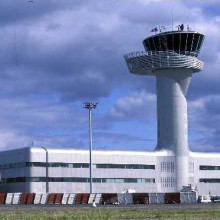
07:31 - Air Traffic Communication
Air Traffic Communication
With the Malaysian Airlines flight MH370 still missing after nearly two weeks, some 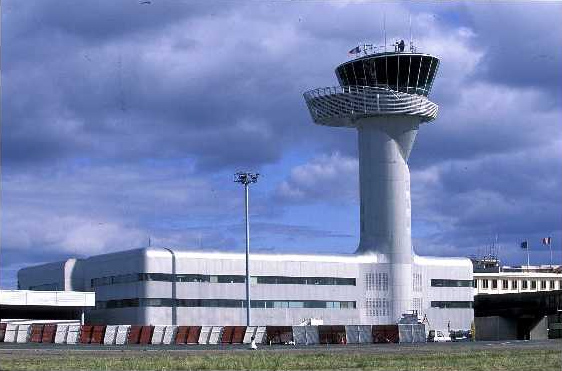 people are asking how you can lose a plane, but with over 6000 aeroplanes flying above us every day it's essential that air traffic control keeps in contact with them all. Here's your quick fire science on how we know where aeroplanes are with Harriet Johnson and Kate Lamble...
people are asking how you can lose a plane, but with over 6000 aeroplanes flying above us every day it's essential that air traffic control keeps in contact with them all. Here's your quick fire science on how we know where aeroplanes are with Harriet Johnson and Kate Lamble...
- In controlled airspace, pilots are guided by air traffic controllers and must provide a flight plan for each journey, including details of their destination and route.
- Air traffic control uses two radar systems to track planes. Primary radar can detect and report the position of any object which reflects the radar signals transmitted. This can be anything from birds to planes to even changes in the landscape.
- Secondary radar allows for more specific information. It links to a transponder onboard the plane which then returns a radio signal to air traffic control. It identifes the plane and provides information on its location.
- Radar signals only travel in straight lines, like light, so if the plane travels too far from the radar it will pass over the horizon and be invisible to air traffic control.
- This often occurs when travelling over large oceans, from then on any location information must be sent by the plane using satellites or high frequency radio.
- Both of these can be used for the Aircraft Communications Addressing and Reporting System or ACARS, which is like a text message system between the plane and air traffic control.
- For electrical and fire safety reasons the communication systems are able to be manually switched off. This also reduces unnecessary signals clogging up the air traffic control when the plane is on the ground.
- The ACARS system and the transponder are believed to of been purposefully switched off on MH370 allowing the Malaysian Airlines plane to effectively disappear.
- But the satellites which can exchange voice messages to and from air traffic control can also send signals which the plane automatically responds to if it is still active. These 'pings' revealed that it continued flying for hours after the loss of the other communication systems.
- The pilot receives additional GPS information with the plane's position, but this is not usually sent to the ground. A new system, automatic dependent surveillance-broadcast, or ADS-B, will incorporate GPS information and is set to replace radar as the main method for tracking flights in the next ten years.
- As the missing plane is no longer transmitting any signals the only way to find it now is to send out search parties and literally look for it. The families of the passengers can only wait and hope.
![BICEP2 Telescope == {{int:filedesc}} == {{Information |Description ={{en|1=The Dark Sector Laboratory at [[:en:AmundsenâScott South Pole Station|AmundsenâScott South Pole Station]]. At left is the [[:en:South Pole Telescope|South Pole Telescope]]. At right is the...](https://www.thenakedscientists.com/sites/default/files/styles/medium/public/media/Dark_sector_laboratory.jpg?itok=1wKEzT2Z)
10:30 - Detecting Gravitational Waves
Detecting Gravitational Waves
with Clement Pryke, University of Minnesota
This week a team of astronomers announced that the BICEP2 radio telescope in ![== {{int:filedesc}} =={{Information|Description ={{en|1=The Dark Sector Laboratory at [[:en:AmundsenâEUR"Scott South Pole Station|AmundsenâEUR"Scott South Pole Station]]. At left is the [[:en:South Pole Telescope|South Pole Telescope]]. At right is the [[:en:BICEP2|BICEP2]] telescope.}}|Source ={{own}}|Author =[[User:Ketiltrout|Ketiltrout]]|Date =2011-01-18|Permission =|other_versions =}}</p><p>[[Category:BICEP]][[Category:South Pole Telescope]]== {{int:license-header}} =={{self|cc-by-sa-3.0|GFDL}} (c) [[User:Ketiltrout BICEP2 Telescope](/sites/default/files/media/Dark_sector_laboratory.jpg) Antarctica had detected evidence of primordial gravitational waves, residual ripples in the fabric of space from the big bang.
Antarctica had detected evidence of primordial gravitational waves, residual ripples in the fabric of space from the big bang.
These findings are very exciting because they may reveal what happened during a period called "inflation" shortly after the birth of the Universe.
To find out more Chris Smith spoke to one of the BICEP2 team Clement Pryke from the University of Minnesota.
Chris - So, kick off first of all and tell us what are gravitational waves.
Clem - Well, gravitational waves are distortions in the fabric of space-time which propagate through space with the speed of light. They can come in various different flavours. As you said, the kind that we are announcing a discovery of this week, are primordial gravitational waves which come from the birth of the universe. There are also gravitational waves potentially produced by compact objects in the nearby universe, but that's a different story.
Chris - So, why has it taken so long to spot these waves? What's special about them that makes them difficult to detect?
Clem - Well, the gravitational waves that we're seeing - what we're doing is we're seeing the imprint of them on the pattern of the cosmic microwave background as it was kind of written at 400,000 years after the beginning. So, in the first 400,000 years, the universe was a hot dense plasma. As it expanded and cooled, eventually, it decoupled and we see the cosmic microwave background coming to us from that time. What we're seeing is a subtle imprint, an additional imprint on that pattern caused by the gravitational waves from that super-early time kind of written in that pattern of 400,000 years. And the only plausible source of those gravitational waves that we're seeing, they fit exactly the predictions for gravitational waves coming from the very, very early universe. So, trillion, trillion, trillionth of a second after the beginning.
Chris - So, to sort of put this into a nutshell, you have a point source which explodes in this catastrophically powerful explosion - the Big Bang. This is impenetrable to our current ways of looking with standard telescopes. And so at the moment, it's something of a black box. We don't know what's gone on in there. It does however produce energy and light which the echoes of which are still knocking around in the universe today and we call that the cosmic microwave background. And you're able to then read out of that signal that's still around today. These waves which you can then use to infer what must have happened in that first 400,000 years or so.
Clem - Right. So, studying the pattern that comes from 400,000 years is a well developed science at this point. So, we've been studying that for several years. The temperature and isotropy, the temperature ripples as it were, just the differences in brightness from place to place on the sky and then measuring the polarization pattern. And to start with, we were measuring the kind of generic version of polarisation which occurs just because you have small deviations in density. That's called E mode polarisation. So, the big deal this week is the first detection of B mode polarisation. The B mode is the kind of swirliness of the polarisation pattern. If you think of a bunch of little vectors on the sky and then if you decompose the pattern, if you can see a kind of swirl in it, that's the signature of the gravitational waves. As I said, those gravitational waves come from the very, very beginning. It's a way of seeing back further. As you said, we can't see back using light any further that 400,000 years, but we can use the gravitational waves to get information about earlier times still.
Chris - What can they tell you and what are they telling you about what happened during that first 400,000 years or so?
Clem - What this week's discovery is all about is the first trillion, trillion, trillionth of a second, right? And in that period of time, there's this theory, this hypothesis that the universe hyperinflated, expanded essentially superluminally, for a tiny fraction of a second by an enormous factor. That process of inflation sets up the initial conditions for the subsequent hot Big Bang. So, this is essentially kind of a preface before the hot Big Bang. And there's been strong suspicion that this inflation actually did occur based on various observations about those initial conditions. But there was an additional prediction from that theory that the inflation process should have injected gravitational waves into the fabric of space time. But they'd never been seen. And so, that's the big deal this week, that we actually see a new prediction from inflation. So, this is kind of a smoking gun that inflation is actually the correct theory for the birth of the universe.
Chris - I mean, having a look online and Peter Coles is Professor of Theoretical Astrophysics at Sussex University. He's got a blog and he says that he is slightly sceptical of what you're finding because he's saying, if you look at your results, you've only found this in one particular frequency regime of microwave, the polarisation, the twist. Why haven't you found this in others or have you just not looked in other frequencies?
Clem - So, we're very convinced the signal that we've found is true and on the sky, but then the question is, what is it? Is it really the primordial signal that we think we're seeing or could it potentially be foreground emission from our own galaxy. So, while our galaxy emits rather weakly at these wavelengths, it still does a little bit and we're down at a fantastic level of sensitivity now. So, the concern is that since we've only really achieved really high sensitivity at one frequency at 150 gigahertz, potentially, we don't have a guard that this signal isn't galactic foreground because the foreground would have a different frequency spectrum than the thermal emission from the cosmic microwave background. If you have multiple frequencies, you can discriminate different kinds of signal that you can rule out foregrounds. Now, we have ruled out foregrounds to reasonably good confidence, but he's right that it's not as high as one would like.
Chris - And the European Space Agency have spent an absolute arm and a leg sending the Planck Mission into space to make these sorts of measurements. They haven't found this yet or at least they haven't said so. So, why did your telescope in Antarctica find it, apart from the fact that you're obviously very clever and they didn't?
Clem - So we stuck our necks out further. So, we're a small ground based experiment and highly targeted. So, we designed the experiment specifically to look for these primordial gravitational waves. And had we not found them then we would've basically been empty handed. Whereas the Planck Mission which is vastly more expensive as you say is much more general. So, it can do all sorts of science with the standard kind of CMB anisotropies and also, with galactic science, and a lot of things. It's a very general experiment. And so basically, the reason that we're first is just because we decided to target this very specific niche science and go after it very aggressively.
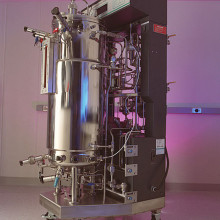
16:50 - Does bioethanol work commercially?
Does bioethanol work commercially?
Mark Peplow - The next couple of months could be a real make or break time for a new form 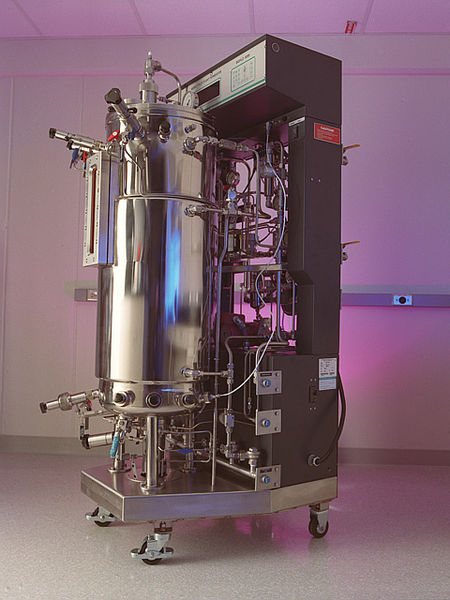 of biofuel that's been promised for years, but it's only now, starting to reach the market in meaningful amounts. Biofuels are meant to cut climate changing carbon dioxide emissions by replacing petrol in our cars. As the plants grow, they suck up carbon dioxide from and atmosphere. So, if you turn the crop into a fuel it shouldn't in theory emit any extra carbon dioxide.
of biofuel that's been promised for years, but it's only now, starting to reach the market in meaningful amounts. Biofuels are meant to cut climate changing carbon dioxide emissions by replacing petrol in our cars. As the plants grow, they suck up carbon dioxide from and atmosphere. So, if you turn the crop into a fuel it shouldn't in theory emit any extra carbon dioxide.
Now, the most used biofuel is ethanol. In the US, it's made by fermenting sugars in maize with yeast to make the ethanol, just like brewing beer. But this form of ethanol actually offers pretty modest savings in greenhouse gas emissions and growing so much of it actually raises food prices. So, people have been trying to brew ethanol from agricultural waste instead. There's a lot more leaves and stems. They don't use up any extra farmland and these second generation fuels potentially offer much better carbon dioxide savings.
Dave Ansell - So, if this is so much better. Why aren't we using them already?
Mark - Well, it's been very, very difficult to actually break down the agricultural waste. They contain tough molecules like cellulose and it's taken more than a decade of intensive research to get this process working at a commercial scale. But within the next few months, three big cellulosic ethanol plants are set to come online in the US. So, you would think all is looking rosy, but...
Dave - I'm sensing a 'but' there.
Mark - Yeah, there is a 'but'. Just as cellulosic ethanol is making its commercial debut, it turns out there's actually no market demand for it. The US government programmes to boost biofuel consumption have been so successful that corn ethanol now fulfils the entire need for the US motor fleet which mostly burns 10% ethanol, 90% petrol blend which is called the E10. This factor has been called the blend wall. Even worse, the Environmental Protection Agency is about to pull the rug out from under the cellulosic ethanol producers. It's about to change the rules so that blenders aren't forced to use quite as much of this stuff in their petrol blend that they sell on the forecourts. And producers fear that this is going to leave them with an excess of unsold cellulosic ethanol that they say could cripple their business.
Dave - So, this is basically about politics and economics, and it just isn't going to work unless somehow that's sorted out.
Mark - That's right and there's a couple of ways around this. Exporting the extra ethanol, that's expensive to ship it all the way over to Europe. You could persuade US drivers to use richer ethanol blends maybe in their cars. The cars will run on them, but some people are worried by oil industry funded studies saying it will damage their engines. And to be fair, richer ethanol blends have less energy than straight petrol. So, a tank full just won't take you as far. As a result, science - chemistry in particular - might actually come to the rescue in this problem because with chemical catalysts and high temperature and pressure, you can convert cheaper feedstocks like municipal solid waste - the stuff that we throw away in our bins - directly into petrol which can be dropped straight into the fuel supply. So, you don't have this blend wall problem that ethanol faces and a commercial plant doing the front end of this process is about to come online in Canada in the summer.
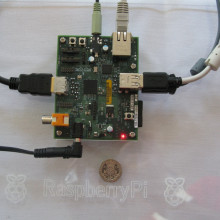
20:10 - Devouring Raspberry Pi
Devouring Raspberry Pi
with Eben Upton, Carrie Anne Philbin, Raspberry Pi
2014 has been declared to be the Year of Code, with one campaign aiming to encourage people across the country to get coding for the first time.
This September even, computer programming will be introduced to the school timetable for every child between 5 and 16, making the UK the first major economy in the world to implement this on a national level.
So why is coding, and getting kids into computer science so important? Chris Smith was joined by Eben Upton and Carrie Anne Philbin from the Raspberry Pi Foundation...
Chris - So, tell us first of all Eben, what is a Raspberry Pi? You better start off and explain.
Eben - A Raspberry Pi is a credit card-sized $25 computer that a group of us here in Cambridge created to try and teach kids to code, to try and give kids that experience we used to have in the 1980s.
Chris - I can fondly remember, coming up to Cambridge, it would've been 1984 and going to the Cambridge computer store to buy my BBC model B microcomputer which then taught me the rudiments of computer programming. I was bereft when there was nothing really to replace it in the next decade because I just felt there was nothing there to engage kids the way that that did. And I suppose - was that sort of part of your motivation?
Eben - Absolutely. So, I'm a little younger than you. I got my BBC micro when I was a kid in 1988 and it was a very second-hand, very battered piece of hardware then. But the day I got my BBC micro, my Lego went in a drawer and never came out again because it was just the most transformative experience for me. I'd been a Lego kid and then I was a BBC micro kid from then on.
Chris - Carrie Anne, you're originally a school teacher. You're now obviously working with these guys. So, they obviously regard that your school experience as fundamental to trying to get Raspberry Pi and the coding regime into the classroom. What's the current problem?
Carrie Anne - How do you mean a problem? Do you mean problem for young people?
Chris - Why are we not teaching kids programming in school?
Carrie Anne - Well, I think for a long time, we weren't teaching programming in primary and secondary school. It's just simply because it wasn't on the curriculum. A lot of teachers would not have known how to teach it either. So, it was missing for a long time with a curriculum that wanted to teach young people skills that they thought were necessary for the workplace, digital literacy skills that would make a young person employable later on. And I think what actually happened was programming and the skills of programming - and not just programming, but understanding how computers work and how networks work and what the internet is made up of, and how all that stuff happens all just kind of got lost.
Chris - I mean my feeling as an external to all this is that computer science largely became regarded as a sort of extended workshop in how to make Microsoft word work or how to do a spreadsheet rather than actually fundamentally understanding how you make a computer work.
Carrie Anne - I think a large aspect of the previous curriculum did involve that. I can say I taught the old curriculum and I did have to teach Word and PowerPoint, and Excel. But a good teacher takes that curriculum and they see how they can actually introduce computing concepts to it. I taught sequencing and I taught control quite often in the previous curriculum. I think the movement towards a new curriculum, a computing curriculum is actually being led by teachers, good teachers who saw that we had lost those wonderful skills. I'm old enough also to remember BBC micro. There was one in my primary school classroom and I started turtle graphics on that because I was particularly good at maths in primary school. But as I went through secondary school, I wouldn't consider myself to be very academic. I didn't get A stars and A's at GCSE's, but computer programming, what I was doing at home was empowering me as an individual and that's what led me into my career and ultimately, to bring it back into the classroom.
Chris - Eben, why should someone go and buy Raspberry Pi because quite frankly, you could do with your laptop or your desktop whatever you could do on a Raspberry Pi couldn't you? I mean, it's just Linux, I can install a copy that, it's free and Python is the programming language you're using, I can go and get that for free off the internet and install that on my desktop.
Eben - Absolutely and I think we suggest people should do that. It simply isn't the case though that all children have a laptop or a desktop computer that they can install these tools onto. If they do, they absolutely should. I think the thing that Raspberry Pi that we found that children find very enjoyable about the Raspberry Pi is you can connect into physical hardware. So unlike a PC, it has these interfacing capabilities. It turns out that moving a pixel around on the screen is nowhere near as cool as it was when I was a kid in the 1980s. Moving an object around in the real world is just as cool or possibly even more cool now that you can connect that object to the internet.
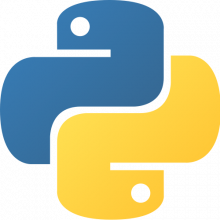
24:50 - Coding Club
Coding Club
with Mark Calleja, Park Street Primary School; Richard Leyland, BANGO; Tamara Sword, TRM&C
One bunch of fledgling coders all attend Park Street Primary School in Cambridge, and 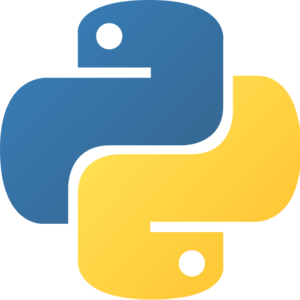 go to an after-school coding club called 'The Park Street Hacker Elite'.
go to an after-school coding club called 'The Park Street Hacker Elite'.
They were thrilled to get 5 free Raspberry Pi's from the foundation in the Year of Code competition, and have successfully sought sponsorship from local tech firm BANGO for the cables and screens to hook them all up.
Before the trainee hackers are let loose on those though, they have to get the rudiments of code straight by learning some of the most basic languages.
Naked Scientist reporter Catherine Carr went along to see them in action..
Mark Calleja - My name is Mr. C and I started the coding club at Park Street Primary.
They're starting to mandate for teachers to be teaching all these sort of coding stuff now. It's getting to the point where lots of teachers are afraid of it because the jargon that they use is quite complex, but the subject itself and the concepts are very, very simple. If you know how to make a cup of tea then you know what an algorithm is because you do the same thing every time, you get the same result, and that's all coding really is.
I think that with the digital age coming around, it's about time that kids started to learn to tell a machine what to do rather than be told by the machine and coding is the first way to get started in that.
Isabella- Go to variables and then there's variables and then click make a variable.
My name is Isabela and I'm playing this game that I made on Scratch called 'Wackawitch'. So basically, what you're meant to do is you make it into full screen and then you click on the flag and then the witches will start disappearing and moving around.
Catherine - So, this is a game that you actually made yourself?
Isabella - Yes, I made it myself.
Mark Calleja - The curriculum that we've got setup for code club has them pushing to be programming in language called Python by the end of an academic year, which is quite a technical language to use for children. When you consider that they have trouble putting captial letters and full stops in their own writing, trying to get curly brackets and the right indents inside coding language could be quite a challenging task. But that's what they're aiming for. I'm hoping just that we can get onto some hard Scratch and have some sort of physical world applications to our coding. So, make a little machine that has a light that blinks or a burglar alarm that takes a photo of somebody that comes in is something real world and physical that we can see a result from.
Richard - My name is Richard Leyland. I'm BANGO's VP of Marketing Communications.
Catherine - So, tell me about the involvement in this coding club and why you decided to do it.
Richard - We're quite interested in the whole idea of coding being a new form of literacy that needs to be taught in schools and we see coding clubs like this as being experimental ventures in that whole idea of teaching coding and it being a new competency that all kids need to have. And so, we're quite happy to support it and be part of it.
Tamara - My name is Tamara Sword and I'm a Technology Marketer. I run a company called TRM&C which helps early stage companies to take new products to market. When I was 8 years old, my dad bought a Commodore 64. Unlike today's gaming consoles, you could actually programme it. It wasn't just about playing games. You could also actually code it yourself and that's what I use to do. I used to write programmes in a language called Basic for my Commodore 64 and I absolutely loved it. But then when I was 11 years old, I went to secondary school and something kind of changed. I stopped coding and looking back, I think the were a variety of issues, but one of them definitely was the fact that when I went to the computing club, it was exclusively boys and all the teachers who could teach computer science were male too. So, I suppose my takeaway aged 11 was, this wasn't the place that I actually belonged and partly as a result I stopped coding.
Mark Calleja - I have 7 girls and 13 boys, everybody was keen. So the shout went out to everybody in Key Stage 2 and it had to be by a ballot. We're supposed to take on 12, so they recommend 12 but we took 20 because I'm a big softie.
Young coder 1 - At home, I have a Raspberry Pi and I found it quite fun to do it with my dad. So, I thought this would be a nice chance to do some more and learn about it more.
Young coder 2 - I came because I just like fiddling with things and that's what you do in a coding.
Catherine - Is there any sense that the kids are super motivated to do these sorts of things because it's a bit more exciting than full stops and capital letters and literacy?
Mark Calleja - Definitely. Writing is something they've done forever and it's a bit mundane, but when they can do their writing and it produces a computer game at the end of it then that reward is huge. Whatever you break on coding, you can fix, but if you mess up with your writing, you have to rub it all out and start again.
Kid - You got to do loads of things and it's really free. You don't just look at it and then copy it off. You sort of make things whatever you want.
Tamara - At the moment, there's a big rallying cry around the year of code that everybody should learn how to code a website. I think that's rather like saying that everybody should learn how to wire their own house. Not strictly true. Well certainly, we need people who could do that, but actually, what's much more important I think is that the foundations of that application, the foundations of coding which is actually computer science is taught in schools, really as a foundational skill.
Catherine - Children in your class must talk about what they want to do when they leave school eventually. How many of them would you say have aspirations to work in this kind of field - tech field, coding field, programming?
Mark Calleja - At this stage, the kids that I deal with, aged 7 to 9, their ideas of career are quite pie in the sky to begin with, you know "I'd like to be an astronaut or an actor, or Superman", but we have one or two children here specifically who are very technology oriented. They have said to me previously what sort of jobs are there available for me in technology, what can I do as a grownup. And so, we've had a chat about that, but it tends to be more boys to be honest who ask those sort of questions than girls I think.
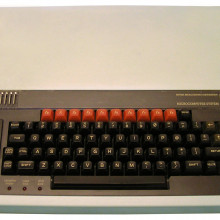
31:20 - Computing in higher education
Computing in higher education
with Eben Upton, Carrie Anne Philbin, Raspberry Pi Foundation, Rob Mullins, Cambridge University.
Coding is being introduced into classrooms but will that mean more people studying it 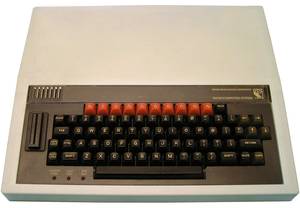 in higher education? Joining Chris Smith and Dave Ansell were Eben Upton and Carrie Anne Philbin from the Raspberry Pi Foundation, and Rob Mullins from the Computing Sciences Department at Cambridge University.
in higher education? Joining Chris Smith and Dave Ansell were Eben Upton and Carrie Anne Philbin from the Raspberry Pi Foundation, and Rob Mullins from the Computing Sciences Department at Cambridge University.
Chris - Let's just return quickly to Eben and Carrie Anne. So you must - having heard that piece about Code Club - be delighted because I mean, that's at the end of the day what you set out to achieve, isn't it Eben.
Eben - Yeah. This is fantastic news and I think what's wonderful for us is when we first started doing this 5 or 6 years ago, we kind of felt a little bit like a voice in the wilderness that we were the only people who were obsessing over this. What's been really wonderful as we've been doing Raspberry Pi is to see that very broad movement of coding clubs in schools of government interest, all kind of coming together into this kind of storm of computer programming this year. It's wonderful.
Chris - Carrie Anne, Catherine Ousselin has got in touch on Twitter with a gauntlet to throw down to you and says, you should try the coding club in French which is what she said. She's in Seattle. She said adventurous teachers try the hour of code in class. "We did it in French class. Our students were in awe that I knew how to code." She points out that she started with the basic too. So maybe that's your next step.
Carrie Anne - I think it's wonderful. Computing is a very creative thing that you can do and it's so cross curricular. I mean, any primary school teachers who are listening who are nervous about the curriculum change, you shouldn't be, because it can actually help them teach lots of other different subjects like history or science, or dance if that's what they've got to do in the classroom. Computing can be applied to all of those things and it's wonderfully cross curricular.
Dave - So Rob, you actually teach computer science here at Cambridge. So, what is actually the difference between computer science and the kind of random hacking which I do?
Rob - I think it's great that people pursue that kind of self-directed learning and hobbyist programming. It's the kind of people we hope to see at interview, people who are able to demonstrate that passion for the subject by actually learning about it in their own time. It's the sort of thing that Raspberry Pi is fantastic to enable people to do. But I suppose the difference is that if you want to answer the question - what's lacking is an understanding of the underlying science and the formal computer science that underpins the subject. So, that's perhaps something that people need to get at university.
Eben - These things, I think they complement each other. There's real value to somebody arriving at Cambridge. Say at the age of 18, having - to get that theoretical basis, having already in their back pocket some experience of the day to day business of hacking. And that's what we used to have and I think that's what we're trying to get back towards.
Dave - So, is there a problem with recruitment at the moment?
Rob - So historically, over the last 10 years, there has been. So we had high numbers of people applying around 2000, 2001, and I guess we had the .com boom and then that took some energy out of applications. The numbers dropped and continued to drop I guess also because of what was happening in schools to about 200 in 2008. So, at that point, I got involved with the Raspberry Pi initiative and people in the lab were getting involved with computing at school and really trying to understand what the problem was and what we could do about it.
Things have really turned around now I think. As Eben says, there's been lots of different groups and lots of different people have really got up behind this idea that computing is a really important skill that people should have to support the economy. It's something that supports tens of billions of pounds of investment in the economy and it's something that's really important. So, we've seen numbers rise back up to more than 500 now. Nationally, I think it's growing faster than any other subject this year.
Chris - What's the impression amongst parents of students either at school Carrie Anne or at your level Rob, about people wanting to do computer science because I've had it said to me that some people get put off by their parents? Because their parents think it's something that's a geeky hobby that's good for your bedroom at weekends and for having fun with your mates playing World of War Craft, but it's not going to lead you into sort of gainful employment.
Rob - I mean, one of the things I've understood, beginning to understand over the last few years, trying to make a difference in this area, there's a lot of misconceptions about what computer science is. And lots of misconceptions about the sort of jobs that a degree in computing can lead to. And I think it's often, what people misunderstand is, they think that a degree in computer science only leads to a job in coding or only something that you do if you want to become a computer scientist. The reality is, computer science is used in just about all the industries now. It's a passport to take a fantastic job anywhere in the world. I think that's beginning to come through now and parents are now understanding that it is a useful degree.
Carrie Anne - I think parents, from what I've seen especially the last few days, talking to parents at the Cambridge Science Festival, they're really enthusiastic about it. Really enthusiastic about the changes that are coming to the curriculum. I think they're actually excited to use Raspberry Pi because they're hoping it will get their children away from closed systems like the iPad and the Xbox and so on. Rather than just consuming technology and playing computer games, they're more excited about the students making the games, their children actually writing the code that will make those computer games.
Dave - So, is the only win going to be people actually working in computer science or is it useful for them just to have the general background knowledge of computing in society?
Eben - We believe very strongly that the skills that you learn as a computer scientist, those skills, they're very, very broadly applicable. We call this computational thinking sometimes and we say computational thinking will make you a better doctor. It will make you a better lawyer. It will make you a better manager. And so really, by giving people access to those things at very, very early age, we're really keying them up to do this very broad range of things in later life.
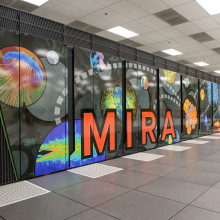
37:22 - Mira the supercomputer
Mira the supercomputer
with Pete Beckman, Argonne National Laboratory
Even if scientists don't study computer science, of course computer modelling is  becoming more and more involved in solving scientific problems from physics to biology.
becoming more and more involved in solving scientific problems from physics to biology.
To find out how it works, Chris Smith took the opportunity to meet up with Pete Beckman from Argonne National Laboratory in Chicago and visit Mira, the fifth-fastest supercomputer in the world.
Pete - So right now, we're in the building which houses our supercomputer Mira. That's its nickname and this data centre here, we refer to as The Core.
Chris - When we say supercomputer, what does that mean?
Pete - Here at Argonne, we try and solve science problems that are so massive, so large that there's no way you can fit this on a couple of machines or laptops or even at Amazon web services. This is a machine which is purpose built to run the absolute, most massive computations you can imagine. So, if I were to try and solve a problem on my laptop that might take a couple of hours, I could do that in a split second on Mira. But the real question is, what about the opposite? If I spent a day of time on Mira, what kind of problem could I solve? If that problem were even to fit in my laptop, it wouldn't fit, but if I just churned it out on my laptop, it would take more than 300 years to compute. So no scientist is going to wait around for more than a couple of days to get their answer, certainly not hundreds of years.
Chris - What sort of problems need that sort of power?
Pete - So, a good example is climate modelling. Another good example is understanding the nature of the universe, so one of the world's largest computations for Big Bang and dark energy and dark matter. We can't wind the clock back and do an experiment in a lab to understand the Big Bang, so we do that experiment with a simulation inside our computer. There are also applications in designing jet engines and designing landing gear, and more commercial applications that companies use because again, it's difficult to build a jet engine that you would like to design and then test it. It's much easier to build that in the computer.
Chris - What actually is the architecture of a supercomputer? How is it constructed?
Pete - So, supercomputers are different than regular machines in that they put a lot of emphasis on floating point operations and moving data very quickly.
Chris - What's a floating point operation?
Pete - Good question. So, if you were to do a simple math problem, A times B plus C, that's called a FLOP. And a FLOP is a floating point operation. And so, one multiply and one add. So, our machine is 10 Peta-FLOPs.
Chris - Does it consist of effectively, one computer connected to another computer, connected to another computer, connected to another computer? So, you've just got hundreds of hundreds of machines all working in parallel or is it more complicated than that?
Pete - Nowadays, we build supercomputers by making them parallel. It isn't the way supercomputers were always built. In the first supercomputers, it was a single computer that was just built to be very, very fast. So, this is the model of the Formula 1 racing car. But now, with the problem so big, there's no way you can make one car drive as fast as you want so you have a fleet. And so, what we have in this room is really a purpose built fleet of CPUs and memory and connection.
Chris - How do you set tasks for it to do?
Pete - So, we have a programming language. The language we use is C and C++ and Fortran. But then we have a series of mechanisms by which we push data and share data back and forth between all of these hundreds of thousands of processors. We literally have hundreds of thousands of CPUs in the machine and that layer is called MPI for Message Passing Interface. And that's what computer scientists learn. They learn how to design algorithms and breakup a scientific problem into thousands of little pieces that can be solved independently.
Chris - And if one of those hundreds of thousands of CPUs dies, do you know and how does that affect the operation of the supercomputer?
Pete - We hear the tree falling, yes and scientists are not happy at all when that happens. Most applications are using a technique that we called checkpoint restart. So, they periodically save their state. It's kind of like with your home computer, you hit Save. The problem is that with so much data in our machine, even just saving that out takes 30 minutes to an hour. So, you can't afford to hit Control S and Save every few minutes. It's something that happens every 6 hours or 8 hours that you would save your checkpoint.
Chris - Is this resource available to scientists at your institution and beyond, and do they just book time on it if they want a problem to be solved?
Pete - Actually, because this is considered a national resource, that means that if you have a good science problem and you write a proposal and convince people that you can solve your science problem with our supercomputer then you get time on it for free. And so, we have people from all over the world who have applied to get time on our supercomputer.
Chris - Can we go in to The Core.
Pete - Yeah, let's go in. It's a little bit noisy in there, so you might not be able to hear me so well. But we're going to open the door, head into The Core and take a look at Mira.
Chris - You're right. It is pretty noisy in here. I'm basically seeing rows and rows of massive black racks.
Pete - Yes. The reason it's so noisy is that a supercomputer runs on several megawatts of power and you have to cool that. And so, right now, what you're hearing are all of the fans blowing air in order to provide cold air. Now Mira is actually unique in this case though because a part of Mira is water-cooled. So, if we didn't have the other supercomputers in here, if we only had Mira, it would actually be pretty quiet. If you were to leave this building and look outside, you'd see the chillers which are providing the cold water.
Chris - What is your electricity bill?
Pete - So, a megawatt of power is about a million dollars a year and Mira needs about 6 megawatts. So, that's about a $6 million a year electric bill which is a lot of money.
Chris - Is that just the computers without the aircon taken into account or does that include your aircon?
Pete - That's just the computer and then the facility is a bit more. But this machine is actually extremely power efficient compared to other computers. So, there's a computer in China and at Oakridge that take 20 megawatts to run and cool. They're much, much less efficient than our machine. So, that is a $20 million electric bill which is kind of hard to fathom.
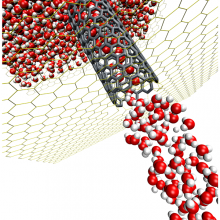
44:07 - Modelling water using ARCHER
Modelling water using ARCHER
with Jason Reese, Edinburgh University
What kind of science does the new breed of supercomputers get used for? This week 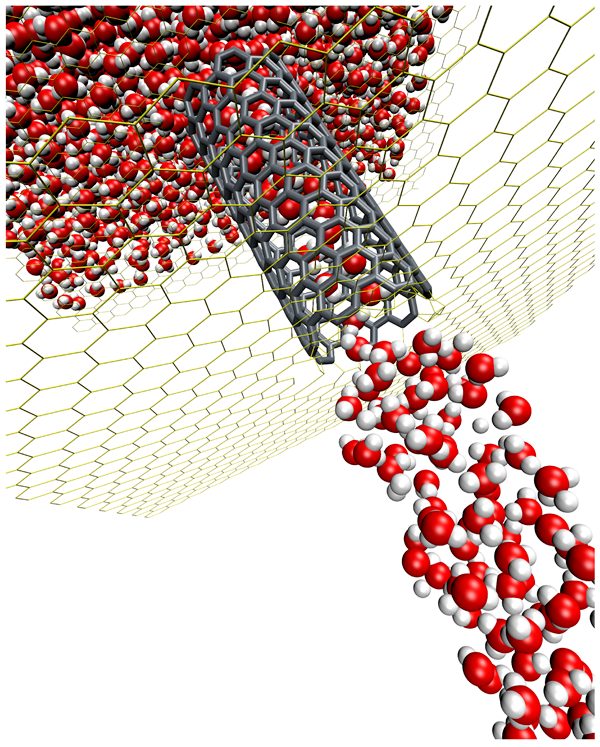 the UKs Engineering and Physical Sciences Reserach Council will announce the launch in Edinburgh of a new 43 Million pound supercomputer called ARCHER - Academic Research Computing High End Resource - capable of more than one million billion calculations a second. Dave Ansell was joined by Jason Reese from Edinburgh University who uses supercomputers for his research...
the UKs Engineering and Physical Sciences Reserach Council will announce the launch in Edinburgh of a new 43 Million pound supercomputer called ARCHER - Academic Research Computing High End Resource - capable of more than one million billion calculations a second. Dave Ansell was joined by Jason Reese from Edinburgh University who uses supercomputers for his research...
Dave - So Jason, what do you use these supercomputers for?
Jason - We use supercomputers for doing engineering simulations. There are 3 ways in which supercomputers are very good for doing these kind of simulations. First, with a supercomputer, you can divide a very big simulation into a number of smaller simulation packets and solve these simultaneously. Second, you can solve many individual problems at the same time. And third, many people can use a supercomputer at once and you can access it remotely. So, if you want to be on the beach in the Caribbean and you've got an internet access or wifi access, you can access these computers.
Dave - Sounds like a good life.
Jason - So, we use these supercomputers in each of those 3 ways. The work that we're doing at the moment is with Duncan Lockerby in Warwick University and David Emerson in Daresbury Lab, and it's funded by the Engineering and Physical Sciences Research Council in the UK. What we're using these supercomputers for is to design new types of filtration membranes to separate pure water from seawater.
Dave - So, this would be ways of getting freshwater if you're in the middle of the dessert but you got the sea next door to you.
Jason - Absolutely. It's the real challenge in engineering at the moment because drinking water is already scarce for more than a billion people around the world and it's probably going to become worse through climate change.
Dave - So, how are you actually trying to do this?
Jason - Our work exploits the fact that fluid dynamics, the way that fluids flow in and around systems changes when you get to the nanoscale, so that's 10 to the -9 of a meter. If you make up filtration membranes of aligned nanotubes and nanotubes, for example carbon nanotubes are rolled up sheets of graphene, but very small diameter, about 1 nanometre in fact in diameter. Water can travel along the nanotubes very quickly, but the sodium and the chloride ions can't travel into the nanotubes because they've got a hydration shell of water molecules around them. So, what this means is if you have a membrane and it's comprised of aligned nanotubes and it could be carbon nanotubes or boron-nitride or silicon-carbide nanotubes. The water will be able to pass through it, but the sodium and the chloride ions wont.
Dave - I guess you didn't need a supercomputer to work out that this might work. Why aren't you just actually going out there and making stuff? Why are you putting it all on a big computer?
Jason - Well, the great thing about supercomputers and computers in general is that you can run simulations for design. So, one of the big questions is, what kind of nanotubes, how would you align them in the membrane, how long should they be, what is the optimum diameter of the nanotubes? And also, before you go and build something, you often want to have a prediction as to how effective it's going to be.
Dave - In your computer, you've got some representation of these little nanotubes. So, are you modelling just how they behave with water or also, how you actually make them because I imagine making a forest of these nanotubes isn't necessarily trivial?
Jason - Making them is a different question, that's right. You often make carbon nanotubes, and they've all got sort of different diameters, and you probably want to separate out the ones that work well in filtration membranes and the ones that don't. The real challenge for the simulations and why you can't do this on your desktop machine is that the water behaves as a molecular substance. If you're going to design a ship or if you're going to design an aeroplant, or even just water flowing in a water mains pipe then you can standard equations of fluid dynamics. But all of those, you have to start questioning and in many cases throw out the window, when you're talking about nanotubes and nanoscale flows because you have to model the individual molecules. So, the reason we use a supercomputer is because we're simulating million or hundreds of thousands or millions of molecules at a time. Each of them interact with each of the other molecules in the simulation and we have to run the simulation for a reasonable amount of time, so we can get the steady state flow properties of these membranes.
Dave - How much computer time are you actually using on this problem?
Jason - Well last year, we used 1 million CPU hours for these simulations. That works out about 140 years of computer time.
Dave - So, what's the next step?
Jason - This is exactly why we are doing the simulations. We've started identifying the best types of nanotubes, the best types of solid molecules for the membranes. Now, we're working with our partners at Bath University, to start testing these. There's been a lot of interest in fluid flows at the nanoscale recently because fluid behaves very differently to what it does around larger scale objects. So, this is just one of the applications of nanoscale fluid dynamics that we're looking at at the moment.

49:30 - Is elevator travel across Earth possible?
Is elevator travel across Earth possible?
Hannah - So, using the Earth's natural spin to help long distance travel across its surface? Engineer, Professor Hugh Hunt from Cambridge University. Hugh - The air around the Earth is moving at the same speed as the Earth. How fast is the Earth moving due its rotation? Well, it's moving at about 1,000 miles an hour which means that if we did sort of hover at rest above the spinning Earth, the wind speed we'd feel would be 1,000 miles an hour. And that would be impossible to deal with unless you had an aerodynamic object like an aircraft with engines to hold yourself against the wind and that's exactly what an aircraft is. Concorde for instance could fly the equator at about 1,000 miles an hour and could stay still essentially. It would hover above the Earth. The Earth would be spinning around underneath it and it would then land somewhere else. If there were no atmosphere, it doesn't solve the problem because we then don't have aerodynamic lift to hold the plane up. So, we have to go into orbit and going to orbit, well the speeds there are even bigger - 20,000 miles an hour and that requires a lot of fuel and a spacecraft.
Hannah - So you, the Earth and the atmosphere are constantly moving very fast as the Earth rotates. If you jump up and somehow managed to stop, you'd be faced with a whopping 1,000-mile per hour winds. Get out of the wind and up into orbit and the fuel you'd have to consume to get there would far exceed the fuel used by a plane which uses the wind currents to their advantage. Another point is that as Newton worked out, objects keep moving at the same velocity unless a force is applied. So, stopping from speed is just as tricky as starting to get to speed in the first place. So even on an airless world, elevator style travel across the Earth using its spin would still use up energy and wouldn't be that different to other modes of transport.










Comments
Add a comment